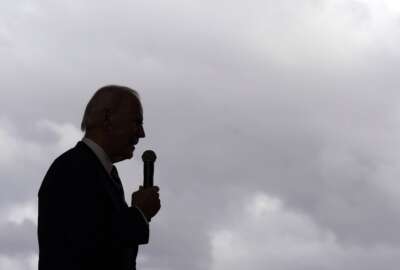
Can the nation get excited over a measly 3 nanometers?
The president in Arizona missed a chance to mark on the importance of microelectronics leadership.
President Joe Biden gets knocked for his verbal gaffes. Give the guy a break, though, for a speech at the Arizona groundbreaking for a new factory. The factory — technically an integrated circuit fabrication plant — will be the second of the Taiwan Semiconductor Manufacturing Company on U.S. soil.
The new plant, at the moment just a future construction site, comes at a complicated time. Supply chains are still tangled from the pandemic. The U.S. has ceded a certain measure of leadership in the integrated circuit industry — a strategic, crucial industry at that. China has turned into a semi-enemy, yet one on which the U.S. economy seems somehow totally dependent. Congress has responded with the CHIPS and Science Act earlier this year.
Biden stumbled over his description of a crucial characteristic of the plant’s output, once it gets built and starts producing.
“They will construct a second fab here in Phoenix to build chips — 3-nano chips,” Biden said. “The 3-nano chip. Chips that are three nano. Any — you know what I’m saying. [Laughter and applause.] Nano no-no. I don’t know. [Laughter.]”
Anyone could stumble in trying to describe details of integrated circuit production. More important, the president missed an opportunity.
Biden referred to the fact that the factory will make chips with 3 nanometer features. That’s known as N3 in the industry. Such terminology is rarely used by the general public, much less by politicians. The president’s staff perhaps should have prepared language more suitable to his speaking style, yet still conveying the importance of 3nm capability.
What it means, roughly, is that the interconnections among the transistors and other components etched within the silicon substrate, will be 3nm wide. This technology allows, the company says, a 70% increase in the amount of logic a chip can contain, relative to a 5nm chip. The 3nm chip will perform its functions 15% faster. A coronavirus gobule, by the way, stretches about 50 nanometers across.
An inventor and Nobel Prize-winning physicist named Jack Kilby made the first IC, containing one transistor and a few passive components. That was in 1958. Today’s ICs each have millions of transistors. At commercial scale, each reduction in chip geometry brings jumps in capability, but at huge cost in research, new equipment and skill. It’s a big challenge going from 5nm to 3nm. The industry is looking at 2nm and 1nm geometries. The European Union committed tens of billions of euros to its indigenous semiconductor industry years before the CHIPS Act.
Older or less sophisticated products than, say, new smart phones, get by with low-priced chips at the mature 10nm and bigger geometries. Kilby’s first crude IC used wires he could hold and solder. Future intelligent products like quantum computers will present new challenges at the microelectronics level. World leadership in technology requires world leadership in microelectronics — hence the president visiting the groudbreaking of an important new factory.
Just over the past weekend, NASA’s Artemis flight concluded successfully when the Orion space capsule parachuted into the ocean. It had orbited the moon. NASA plans to land it there in a couple of years. I got a chuckle from the fact that NASA still televises simulations of what’s going on in space. I recall first seeing “artist renditions” of stages coming apart and so forth back.
John F. Kennedy expanded on the moon mission in a now-famous speech at Rice University in September 1962. In my mind that speech ranks among the great pieces of American rhetoric, flawlessly delivered, and not just because of the “because they are haaahd” line. The speech had an architecture which would required another column to analyze.
In one passage JFK described some of the technical challenges. He said in part, “…we shall send to the moon, 240,000 miles away from the control station in Houston, a giant rocket more than 300 feet tall, the length of this football field, made of new metal alloys, some of which have not yet been invented, capable of standing heat and stresses several times more than have ever been experienced, fitted together with a precision better than the finest watch, carrying all the equipment needed for propulsion, guidance, control, communications, food and survival, on an untried mission, to an unknown celestial body, and then return it safely to earth, reentering the atmosphere at speeds of over 25,000 miles per hour, causing heat about half that of the temperature of the sun… ”
The alloys and precision manufacturing required of the space mission more than a half century ago have acted as an analog in the race to new and exotic chip technologies now. So President Biden was on to something. To those that think about these things, there’s a quality of grandeur in microelectronics, just as there is in the heavens. Both require vast amounts of money, brainpower and will to advance.
The situation analogy is imperfect. Yet JFK and Biden both realized the importance of these endeavors to U.S. worldwide leadership. It’s just that JFK said it better.
Copyright © 2025 Federal News Network. All rights reserved. This website is not intended for users located within the European Economic Area.
Tom Temin is host of the Federal Drive and has been providing insight on federal technology and management issues for more than 30 years.
Follow @tteminWFED




